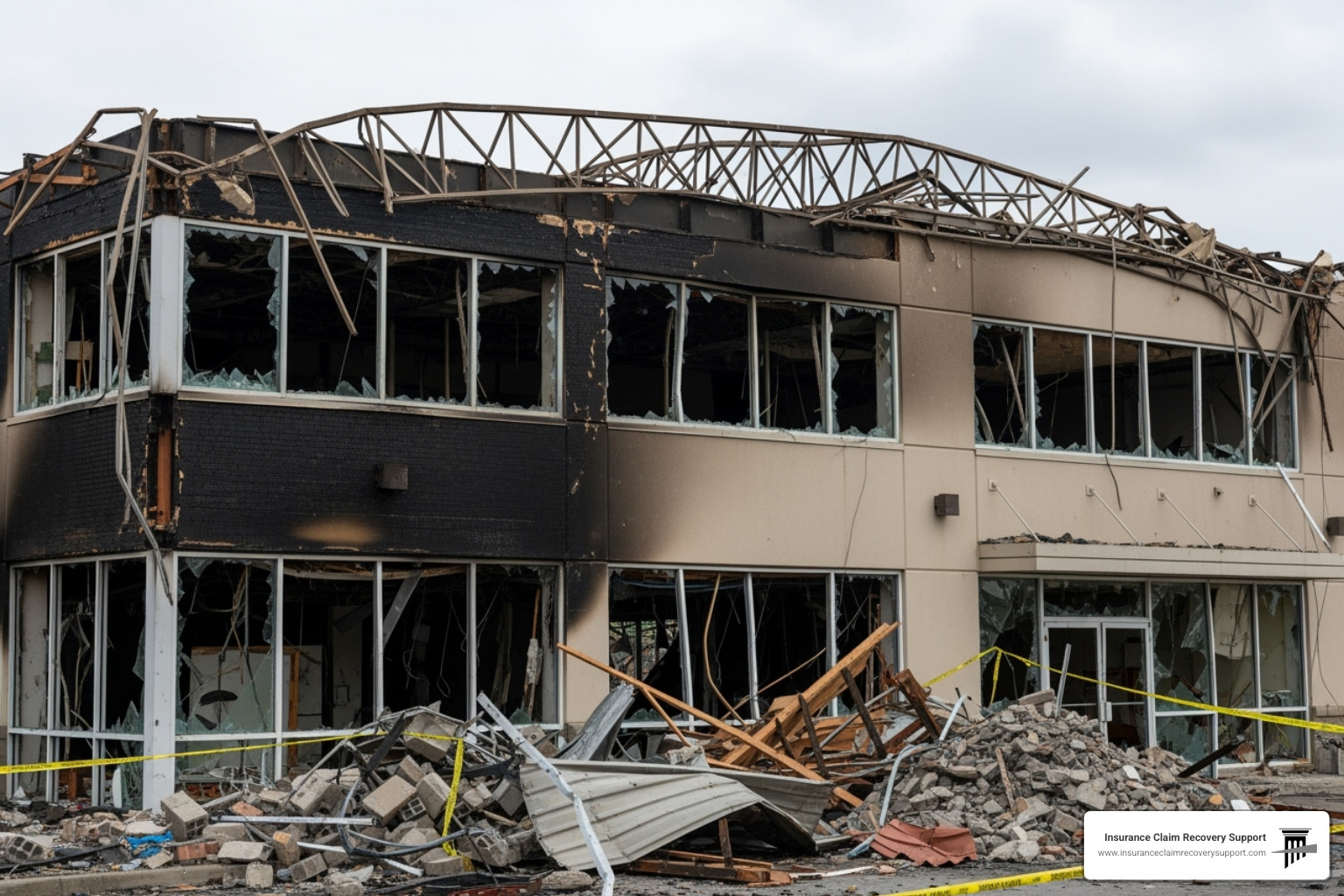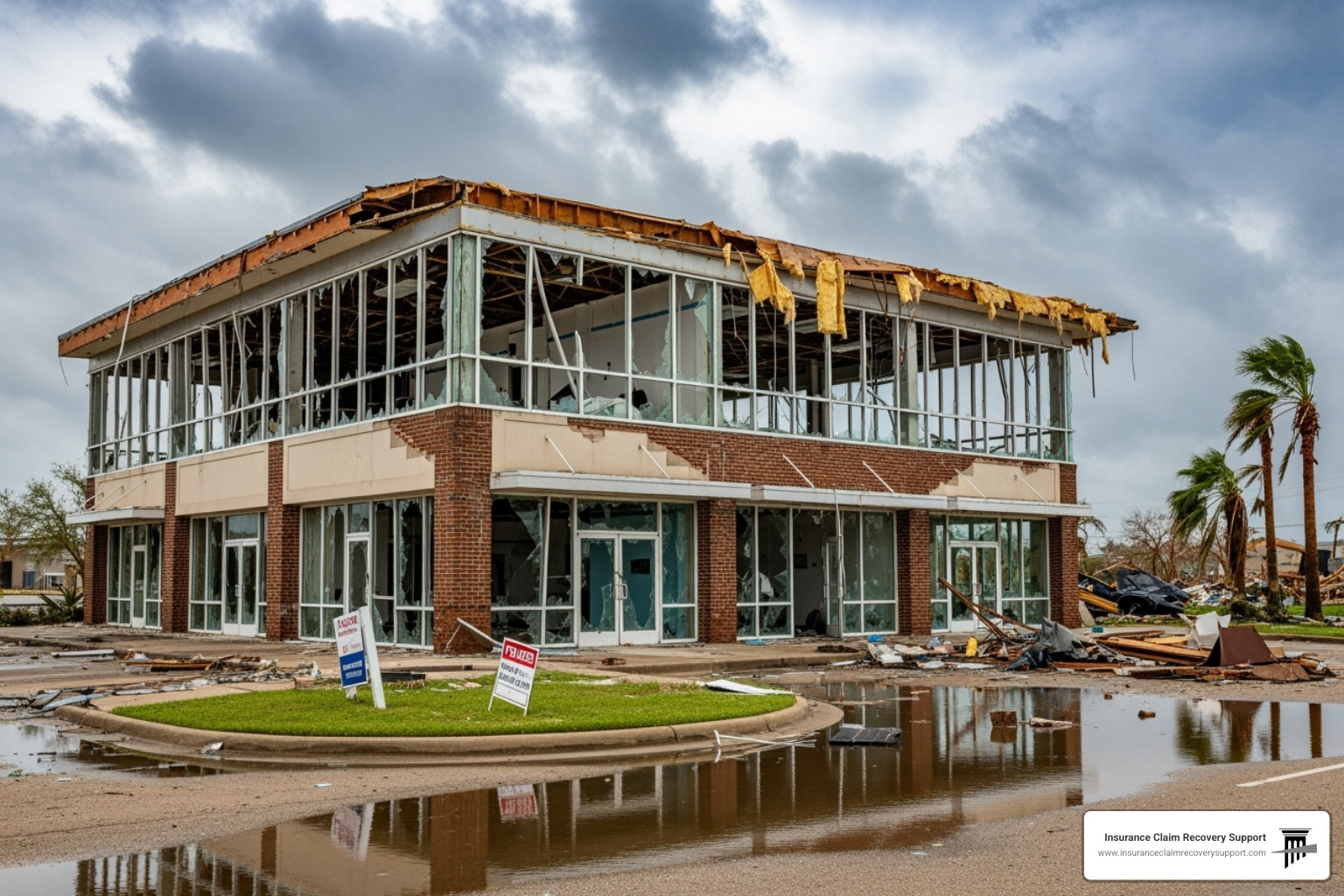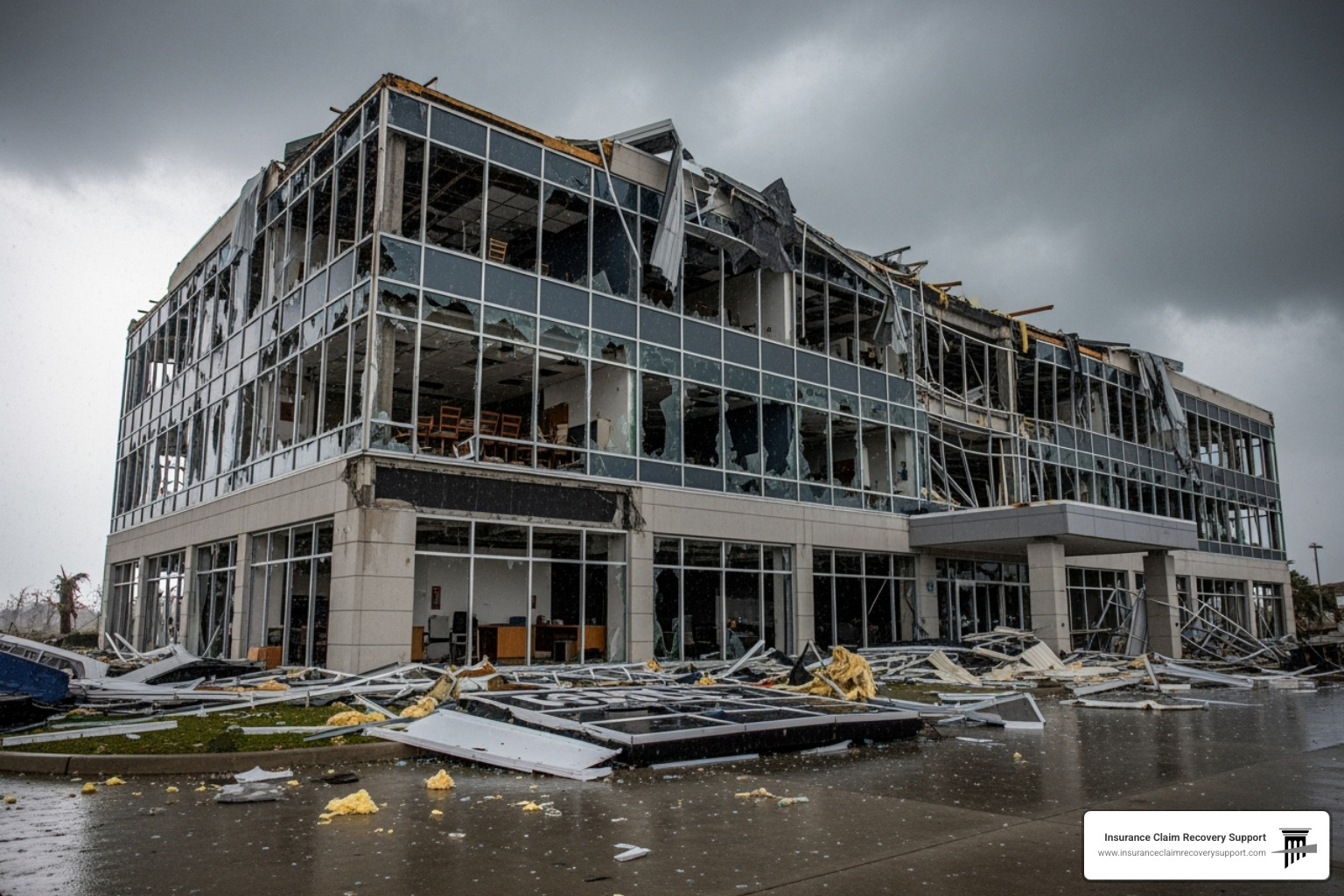Why Loss of Use Claims Are Critical for Your Commercial Property Recovery
A loss of use claim provides essential financial protection when your commercial property becomes unusable from covered damage like fire, hail, hurricane, tornado, freeze, lightning, or flood. This coverage helps replace lost income and covers extra expenses during repairs or rebuilding.
Key Facts About Loss of Use Claims:
- Coverage Type: Compensates for lost business income and additional operating expenses
- Duration: Lasts during the “period of restoration” (time needed to repair/rebuild)
- Common Triggers: Fire, severe weather, water damage, and other covered perils
- Typical Expenses Covered: Lost net income, continuing payroll, temporary relocation costs, equipment rental
- Filing Requirement: Must prove financial loss with detailed documentation
When disaster strikes your commercial building, multifamily complex, or religious facility, the physical damage is just the start. The real financial impact comes from being unable to operate: lost rental income, ongoing expenses without revenue, and temporary operational costs. Insurers often undervalue or deny these claims, leaving property owners struggling.
The claims process is complex. Litigation against your insurer can take years and incur significant legal fees. A more effective approach is hiring a public adjuster who specializes in these claims. Public adjusters work only for policyholders, not insurers, and can often negotiate fair settlements while helping you avoid costly lawsuits.
I’m Scott Friedson, a multi-state licensed public adjuster who has successfully settled over 500 large loss of use claims valued at more than $250 million for commercial and multifamily property owners. My experience includes overturning wrongfully denied claims and increasing settlements from 30% to 3,800% while helping clients avoid unnecessary litigation.

Understanding Loss of Use in Your Commercial Property Policy
When disaster strikes your commercial property, from a Dallas apartment complex to a Houston retail building, the visible damage is just the start. Beyond fixing roofs and floors, you face lost income during repairs. This is where loss of use claim coverage becomes your financial safety net.
Think of it this way: your property insurance has two main jobs. The first is fixing what’s broken (property damage coverage). The second is keeping your business alive while the fixing happens (loss of use claim coverage). Without both, even a “minor” disaster can become a financial catastrophe.
What is Loss of Use Coverage?
Loss of use claim coverage, often called Business Income coverage in commercial policies, is designed to replace the income your property would have generated if not for the disaster. It covers more than just lost rent; it also helps pay for ongoing expenses that continue even when your building is damaged.
If a tornado hits your Fort Worth apartment complex, tenants move out and rental income stops. However, your mortgage, insurance, and property management costs continue. Loss of use claim coverage bridges this financial gap, allowing you to focus on repairs instead of scrambling to pay bills.
This coverage typically kicks in when a covered event (like fire, hurricane, tornado, freeze, lightning, or flood) makes your property unusable or significantly reduces your ability to operate. It’s a financial lifeline that keeps your business from drowning while you’re getting back on your feet.
Covered Expenses: Keeping Your Business Afloat
A comprehensive loss of use claim policy covers more than most property owners realize. Lost net income—the profit you would have earned if your San Antonio retail center hadn’t been damaged by a severe windstorm—is the most obvious component. But the coverage goes deeper.
Continuing operating expenses are often the real budget-busters during a restoration. Your payroll for essential staff continues even when the building is closed. Utilities might increase if you’re running dehumidifiers. Loan payments don’t pause for property damage. These fixed costs can quickly drain your reserves if you’re not properly covered.
If your property becomes uninhabitable, temporary relocation costs can help you rent alternative space. A damaged church in Round Rock might need to rent a community center for services. An apartment complex might need to provide temporary housing assistance to displaced tenants.
Marketing expenses to announce your temporary location or communicate with tenants are also typically covered. When your Georgetown office building reopens after flood damage, you’ll need to let everyone know you’re back in business.
Finally, rental of temporary equipment ensures you can maintain operations. This might include everything from temporary HVAC units to replacement kitchen equipment for a damaged restaurant.
Business Interruption vs. Loss of Use
The terms “Business interruption” and “loss of use claim” are closely related but have key differences that can affect your coverage.
Business interruption is the broader term for financial losses when your business can’t operate due to property damage. Loss of use claim specifically focuses on your inability to use the damaged property.
The key concept for both is the “period of restoration.” This is the reasonable time needed to repair or rebuild and resume normal operations. For a tornado-damaged Waco warehouse, this period ends when you are fully operational, not just when construction finishes.
The triggering events are the same: fire, flood, tornado, and other covered perils in your policy. However, you need direct physical damage to trigger the coverage. A nearby flood that doesn’t damage your Lubbock facility won’t typically trigger loss of use claim benefits, even if it prevents customers from reaching you.
Understanding these distinctions is crucial when dealing with your insurer’s adjuster. Having a public adjuster on your side who understands these nuances can mean the difference between a fair settlement and an underpayment. Rather than facing years of litigation, a skilled public adjuster can negotiate a proper settlement that gets your business back on track without courtroom drama.
The Essential Guide to Filing a Loss of Use Claim
When your commercial property is damaged, filing a loss of use claim can feel overwhelming. However, the process is manageable with a clear plan and careful documentation. This guide will help you steer the steps to get the settlement you deserve.
Step-by-Step Claim Filing Process
Navigating the claims process requires precision and patience. Here’s a step-by-step guide to manage your loss of use claim:
First, once it is safe, assess the damage to your property. Take extensive photos and videos from every angle.
Next, notify your insurance company immediately. Give them the basic details of what happened.
After that, it’s crucial to mitigate further damage. This means taking reasonable steps to prevent the situation from worsening, like placing a tarp over a damaged roof. Keep all receipts for these efforts.
Next, document everything. This includes every expense, all lost income, and each communication with your insurer. This documentation is your most critical tool.
Finally, after gathering all necessary information, submit your *loss of use claim formally* to your insurance company.

For instance, if a fire devastates a Dallas apartment complex, our initial steps would involve securing the property, documenting the fire damage, and immediately notifying the insurer. Then, the detailed work of quantifying the loss of use claim begins, which includes lost rental income from uninhabitable units and increased operating costs.
Proving Your Loss of Use Claim: A Documentation Checklist
Proving your loss of use claim depends on solid financial evidence. The stronger your proof, the better your chance of a fair settlement. Gather the following documents:
- Financial records: Profit & Loss (P&L) statements, tax returns from previous years, and sales records. These show your business’s financial health before the incident.
- Invoices for extra expenses: Keep invoices for all additional costs incurred due to the loss, such as temporary office rent or equipment leases.
- Lease agreements for temporary space: Your lease agreements for temporary space are crucial proof of relocation costs.
- Communication logs with the insurer: Maintain a detailed log of all communications—calls, emails, letters—with your insurance company and its adjusters.
- Contractor bids: Get detailed bids from licensed and reputable contractors for the necessary repairs to help establish the “period of restoration.”
- Repair timelines: Any projected repair schedules from contractors will be helpful in determining how long your loss of use claim should last.
The more thorough your documentation, the stronger your claim will be—especially in places like Austin or San Antonio, where storm damage is common.
The Public Adjuster Advantage: Settlement vs. Lawsuit
Filing a complex loss of use claim for a large commercial property can feel like an uphill battle. The insurance company’s adjuster works to protect the insurer’s bottom line, which often means minimizing your payout.
This is why having a public adjuster is a game-changer. We work only for you, the policyholder. Our mission is to level the playing field and ensure you get every penny you’re entitled to.
Frustrated policyholders might consider an insurance claim lawsuit, but litigation is often a long, expensive, and stressful process that can take years. Our approach is different. We focus on expert negotiation.
We carefully prepare your loss of use claim, backing it with solid financial data and expert analysis, and present it to the insurer in a way that’s hard to dispute. This often leads to a fair settlement much faster than going to court.
Common reasons for claim denial or underpayment include insufficient proof or disputes over the “period of restoration.” We anticipate these challenges and build a rock-solid case to counter them, helping you avoid unnecessary litigation and focus on rebuilding. Our commitment at Insurance Claim Recovery Support is to advocate fiercely for policyholders to ensure you receive the maximum settlement you deserve.
More info about public adjuster services
Calculating Your Claim’s Value and Overcoming Problems
Determining your loss of use claim’s true value is a complex process. It involves analyzing financial history, projecting losses, and navigating insurer challenges. With the right approach and documentation, you can overcome these obstacles and secure a fair settlement.
How Your Loss of Use Payout is Determined
Calculating your loss of use claim payout involves creating a financial picture of your business absent the disaster. This methodical process combines forensic accounting with real-world business analysis.

The foundation of a strong claim is your historical business performance. We analyze financial records—P&L statements, tax returns, and revenue reports—to understand your business’s rhythm and seasonal patterns. For an Austin apartment complex, we would examine occupancy rates and rental income trends compared to the local market.
Next is the projected income analysis. We combine your historical data with current industry trends to accurately project what you would have earned during the interruption. We consider market conditions, planned improvements, and economic factors.
Of course, we must also carefully review your policy limits and sub-limits. Insurance policies have various caps that affect your payout. We ensure our calculations align with your coverage while pushing for the maximum settlement allowed.
For example, if a freeze hits your San Antonio multifamily property, we’d analyze typical winter occupancy, factor in planned rent increases, and calculate not just lost rent but also extra expenses like temporary housing for tenants or emergency repairs.
Common Reasons for Claim Denial or Underpayment
Even a well-documented loss of use claim can face pushback from insurers. Understanding their common tactics helps us build stronger cases.
Insufficient proof of loss is the top reason for denial or underpayment. Insurers scrutinize every receipt and challenge any incomplete documentation.
Insurance companies also frequently dispute the “period of restoration,” arguing you took too long to resume business or failed to act quickly to minimize losses.
Another tactic involves allegations of non-covered perils. Even with obvious tornado damage in Lubbock or hurricane damage in Houston, insurers might argue the damage came from an excluded cause, like a flood.
Policy exclusions can trip up property owners. Insurers will search the fine print for any exclusion that might apply. Finally, they often claim failure to mitigate damages, arguing you didn’t take reasonable steps to prevent further loss.
Insurance companies have expert teams working to minimize payouts. A public adjuster levels the playing field. Instead of facing years of costly litigation, we negotiate directly with insurers using our expertise, working exclusively for you.
The Impact of Texas Law on Your Claim
Texas property owners have specific legal protections that can significantly impact a loss of use claim. Understanding these rights, as outlined by resources like the Texas Department of Insurance, can mean the difference between a fair settlement and a protracted legal battle.
State-specific regulations in Texas provide strong protections against bad faith insurance practices. Insurers cannot deny or underpay claims without a reasonable basis. If they do, Texas law allows for remedies that may include damages beyond your original claim amount.
Your policyholder rights in Texas are robust. You are entitled to a prompt claim investigation, clear communication, and fair settlement offers based on your policy. Insurers must provide specific reasons for any denial or underpayment.
Deadlines for filing are critical. Waiting too long to file your claim can jeopardize your recovery, which is a key concern for properties in areas like Dallas or Fort Worth that experience frequent severe weather.
Legal precedents in Texas often favor policyholders who can show they have documented and mitigated their losses in good faith. Courts have reinforced that insurers must honor the reasonable expectations of policyholders.
The advantage of working with an experienced public adjuster is our deep understanding of these legal developments. We use this knowledge to strengthen your negotiating position, leveraging Texas law to secure fair settlements and help you avoid expensive litigation. This approach gets you back to business faster, without the uncertainty of a courtroom battle.
Frequently Asked Questions about Loss of Use Claims
When you’re dealing with property damage and potential income loss, questions naturally arise about how loss of use claim coverage actually works. Let me address the most common concerns I hear from commercial property owners across Texas.
How long does loss of use coverage last for a commercial property?
The duration of your loss of use claim coverage depends on the “period of restoration”—the reasonable time it takes to get your property back to its pre-loss condition. This period starts with the direct physical damage and continues until you can resume normal operations.
It’s not about how long you want to take, but how long it should reasonably take. Insurers expect you to work diligently to restore your property. If repairs to your Houston apartment complex should take six months, but you delay work for three, your coverage may not extend to that delay.
Coverage also stops when you hit your policy’s coverage limit, whichever comes first. Understanding your policy limits upfront is crucial.
Do I need to be completely shut down to file a loss of use claim?
Not at all. This is a common misconception. You can file a loss of use claim for partial business interruption.
For example, if a severe freeze in Waco damages your apartment complex’s plumbing and makes half the units uninhabitable, you have a valid loss of use claim for the lost income, even if you’re still collecting rent from the other half. The same applies if a tornado in Lubbock damages part of your commercial building, forcing you to operate at reduced capacity.
The key is demonstrating how the covered damage reduced your income or increased your expenses. You can claim for the percentage of loss plus any extra costs incurred to maintain operations. Clear documentation is especially important in these partial loss situations.
Can I handle a complex loss of use claim without professional help?
While you technically can, it’s not advisable for significant claims. Loss of use claims demand specialized knowledge of policy language, forensic accounting, and negotiation skills that most property owners lack.
These claims involve extensive financial documentation and sophisticated financial modeling to prove not just what you lost, but what you would have earned.
The insurance company employs a team of experts—adjusters, accountants, and lawyers—focused on minimizing their payout. Facing them alone puts you at a significant disadvantage.
A public adjuster levels the playing field. We manage the complex documentation, handle the forensic accounting, and negotiate from a position of expertise. Our goal is to help you avoid costly and lengthy litigation. Instead of suing your insurer, our approach focuses on achieving a fair settlement through skilled negotiation, getting you paid faster and without the stress of court.
The bottom line? For anything beyond a minor claim, professional help is essential for protecting your financial interests and ensuring you receive the maximum settlement you deserve.
Conclusion: Secure Your Business’s Future
When disaster strikes, recovery goes beyond physical repairs. The financial impact of lost income and ongoing expenses during restoration can be devastating. Properly managing your loss of use claim is not just smart; it’s essential for your business’s survival.
The difference between a successful recovery and a financial catastrophe often depends on how you manage the claims process. Insurance companies have expert teams working to minimize payouts, using complex policy language and tactics. Without proper representation, you can face denial, underpayment, or endless delays.
Expert advocacy is your financial lifeline. A skilled public adjuster tips the scales in your favor. Rather than facing years of costly litigation, our professional claim management uses thorough documentation and strategic negotiation to achieve maximum settlements efficiently.

At Insurance Claim Recovery Support, we’ve seen how proper claim management transforms outcomes. Our experience with over 500 large loss of use claims valued at more than $250 million has taught us that proactive, expert-driven advocacy makes all the difference. Whether you’re managing an apartment complex in Austin, a commercial building in Houston, or a religious institution in San Antonio, the principles are the same: thorough preparation, meticulous documentation, and skilled negotiation.
Your business’s future depends on securing the financial resources to rebuild stronger. Don’t let an insurer’s initial offer determine your recovery. With professional advocacy, you can achieve the peace of mind that comes from receiving every dollar you deserve, allowing you to focus on what matters most: getting back to business.






